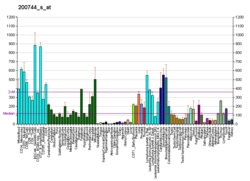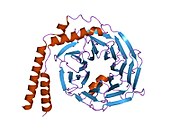GNB1
—
Guanine nucleotide-binding protein G(I)/G(S)/G(T) subunit beta-1 is a protein that in humans is encoded by the GNB1 gene.[5]
Function
[edit]Heterotrimeric guanine nucleotide-binding proteins (G proteins), which integrate signals between receptors and effector proteins, are composed of an alpha, a beta, and a gamma subunit. These subunits are encoded by families of related genes. This gene encodes a beta subunit. Beta subunits are important regulators of alpha subunits, as well as of certain signal transduction receptors and effectors. This gene uses alternative polyadenylation signals.[5][6]
Interactive pathway map
[edit]Click on genes, proteins and metabolites below to link to respective articles.[§ 1]
- ^ The interactive pathway map can be edited at WikiPathways: "NicotineDopaminergic_WP1602".
Interactions
[edit]GNB1 has been shown to interact with GNG4.[7][8]
Mutations
[edit]Mutations in the GNB1 gene can cause developmental delays, seizures, and other health problems. The GNB1 Advocacy Group is the primary organization in the United States connecting patients to each other and to researchers working to cure the effects of these mutations.
www.facebook.com/groups/gnb1advocacy/
https://www.ncbi.nlm.nih.gov/books/NBK554743/
References
[edit]- ^ a b c GRCh38: Ensembl release 89: ENSG00000078369 – Ensembl, May 2017
- ^ a b c GRCm38: Ensembl release 89: ENSMUSG00000029064 – Ensembl, May 2017
- ^ "Human PubMed Reference:". National Center for Biotechnology Information, U.S. National Library of Medicine.
- ^ "Mouse PubMed Reference:". National Center for Biotechnology Information, U.S. National Library of Medicine.
- ^ a b "Entrez Gene: GNB1 guanine nucleotide binding protein (G protein), beta polypeptide 1".
- ^ Ogorodnikov A, Levin M, Tattikota S, Tokalov S, Hoque M, Scherzinger D, Marini F, Poetsch A, Binder H, Macher-Göppinger S, Probst HC, Tian B, Schaefer M, Lackner KJ, Westermann F, Danckwardt S (December 2018). "Transcriptome 3'end organization by PCF11 links alternative polyadenylation to formation and neuronal differentiation of neuroblastoma". Nat. Commun. 9 (1): 5331. Bibcode:2018NatCo...9.5331O. doi:10.1038/s41467-018-07580-5. PMC 6294251. PMID 30552333.
- ^ Ray K, Kunsch C, Bonner LM, Robishaw JD (September 1995). "Isolation of cDNA clones encoding eight different human G protein gamma subunits, including three novel forms designated the gamma 4, gamma 10, and gamma 11 subunits". J. Biol. Chem. 270 (37): 21765–71. doi:10.1074/jbc.270.37.21765. PMID 7665596.
- ^ Yan K, Kalyanaraman V, Gautam N (March 1996). "Differential ability to form the G protein betagamma complex among members of the beta and gamma subunit families". J. Biol. Chem. 271 (12): 7141–6. doi:10.1074/jbc.271.12.7141. PMID 8636150.
Further reading
[edit]- Downes GB, Gautam N (1999). "The G protein subunit gene families". Genomics. 62 (3): 544–52. doi:10.1006/geno.1999.5992. PMID 10644457.
- Levine MA, Modi WS, O'Brien SJ (1990). "Chromosomal localization of the genes encoding two forms of the G protein beta polypeptide, beta 1 and beta 3, in man". Genomics. 8 (2): 380–6. doi:10.1016/0888-7543(90)90296-7. PMID 1979057.
- Codina J, Stengel D, Woo SL, Birnbaumer L (1986). "Beta-subunits of the human liver Gs/Gi signal-transducing proteins and those of bovine retinal rod cell transducin are identical". FEBS Lett. 207 (2): 187–92. doi:10.1016/0014-5793(86)81486-7. PMID 3095147. S2CID 22783787.
- Buhl AM, Osawa S, Johnson GL (1995). "Mitogen-activated protein kinase activation requires two signal inputs from the human anaphylatoxin C5a receptor". J. Biol. Chem. 270 (34): 19828–32. doi:10.1074/jbc.270.34.19828. PMID 7649993.
- Ray K, Kunsch C, Bonner LM, Robishaw JD (1995). "Isolation of cDNA clones encoding eight different human G protein gamma subunits, including three novel forms designated the gamma 4, gamma 10, and gamma 11 subunits". J. Biol. Chem. 270 (37): 21765–71. doi:10.1074/jbc.270.37.21765. PMID 7665596.
- Kozasa T, Gilman AG (1995). "Purification of recombinant G proteins from Sf9 cells by hexahistidine tagging of associated subunits. Characterization of alpha 12 and inhibition of adenylyl cyclase by alpha z". J. Biol. Chem. 270 (4): 1734–41. doi:10.1074/jbc.270.4.1734. PMID 7829508.
- Tsukada S, Simon MI, Witte ON, Katz A (1994). "Binding of beta gamma subunits of heterotrimeric G proteins to the PH domain of Bruton tyrosine kinase". Proc. Natl. Acad. Sci. U.S.A. 91 (23): 11256–60. Bibcode:1994PNAS...9111256T. doi:10.1073/pnas.91.23.11256. PMC 45206. PMID 7972043.
- Ueda N, Iñiguez-Lluhi JA, Lee E, Smrcka AV, Robishaw JD, Gilman AG (1994). "G protein beta gamma subunits. Simplified purification and properties of novel isoforms". J. Biol. Chem. 269 (6): 4388–95. doi:10.1016/S0021-9258(17)41792-3. PMID 8308009.
- Wall MA, Coleman DE, Lee E, Iñiguez-Lluhi JA, Posner BA, Gilman AG, Sprang SR (1995). "The structure of the G protein heterotrimer Gi alpha 1 beta 1 gamma 2". Cell. 83 (6): 1047–58. doi:10.1016/0092-8674(95)90220-1. PMID 8521505. S2CID 18993038.
- Sondek J, Bohm A, Lambright DG, Hamm HE, Sigler PB (1996). "Crystal structure of a G-protein beta gamma dimer at 2.1A resolution". Nature. 379 (6563): 369–74. Bibcode:1996Natur.379..369S. doi:10.1038/379369a0. PMID 8552196. S2CID 4321948.
- Andersson B, Wentland MA, Ricafrente JY, Liu W, Gibbs RA (1996). "A "double adaptor" method for improved shotgun library construction". Anal. Biochem. 236 (1): 107–13. doi:10.1006/abio.1996.0138. PMID 8619474.
- Mattingly RR, Macara IG (1996). "Phosphorylation-dependent activation of the Ras-GRF/CDC25Mm exchange factor by muscarinic receptors and G-protein beta gamma subunits". Nature. 382 (6588): 268–72. Bibcode:1996Natur.382..268M. doi:10.1038/382268a0. PMID 8717044. S2CID 4333145.
- De Waard M, Liu H, Walker D, Scott VE, Gurnett CA, Campbell KP (1997). "Direct binding of G-protein betagamma complex to voltage-dependent calcium channels". Nature. 385 (6615): 446–50. Bibcode:1997Natur.385..446W. doi:10.1038/385446a0. PMID 9009193. S2CID 4287544.
- Huang CL, Jan YN, Jan LY (1997). "Binding of the G protein betagamma subunit to multiple regions of G protein-gated inward-rectifying K+ channels". FEBS Lett. 405 (3): 291–8. doi:10.1016/S0014-5793(97)00197-X. PMID 9108307. S2CID 44072628.
- Yu W, Andersson B, Worley KC, Muzny DM, Ding Y, Liu W, Ricafrente JY, Wentland MA, Lennon G, Gibbs RA (1997). "Large-scale concatenation cDNA sequencing". Genome Res. 7 (4): 353–8. doi:10.1101/gr.7.4.353. PMC 139146. PMID 9110174.
- Qin N, Platano D, Olcese R, Stefani E, Birnbaumer L (1997). "Direct interaction of gbetagamma with a C-terminal gbetagamma-binding domain of the Ca2+ channel alpha1 subunit is responsible for channel inhibition by G protein-coupled receptors". Proc. Natl. Acad. Sci. U.S.A. 94 (16): 8866–71. Bibcode:1997PNAS...94.8866Q. doi:10.1073/pnas.94.16.8866. PMC 23172. PMID 9238069.
- Nishida K, Kaziro Y, Satoh T (1999). "Association of the proto-oncogene product dbl with G protein betagamma subunits". FEBS Lett. 459 (2): 186–90. doi:10.1016/S0014-5793(99)01244-2. PMID 10518015. S2CID 83524892.
- Huang L, Shanker YG, Dubauskaite J, Zheng JZ, Yan W, Rosenzweig S, Spielman AI, Max M, Margolskee RF (1999). "Ggamma13 colocalizes with gustducin in taste receptor cells and mediates IP3 responses to bitter denatonium". Nat. Neurosci. 2 (12): 1055–62. doi:10.1038/15981. PMID 10570481. S2CID 24494794.
- Carman CV, Barak LS, Chen C, Liu-Chen LY, Onorato JJ, Kennedy SP, Caron MG, Benovic JL (2000). "Mutational analysis of Gbetagamma and phospholipid interaction with G protein-coupled receptor kinase 2". J. Biol. Chem. 275 (14): 10443–52. doi:10.1074/jbc.275.14.10443. PMID 10744734.




















